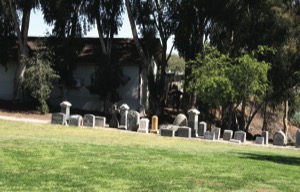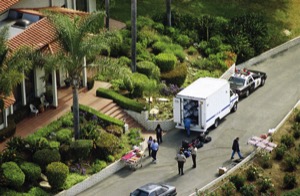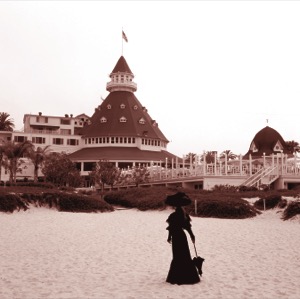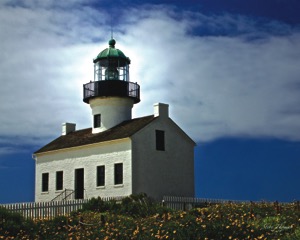
Jack-o-lanterns leering from the porch. Arch-backed black cats hissing in the shadows. Goblins and ghouls trick-or-treating door to door scurried along by the scuttle of dry leaves. Overhead, a beat-up quarter-moon bandaged by ragged clouds.
Halloween. The time of year when the shiver running down your spine might be attributed to something other than the evening chill. The time of year for visiting haunted houses and telling ghost stories.
I invited my cherished friend Miss Jean Brodie to accompany me on a tour of local “haunts” – places where people have died and yet are reported to manifest themselves in harmless ways. We visited San Diego’s most notorious paranormal hotspots before spending the night in a nondescript motel just off Interstate 5. Miss Jean Brodie adores everything phantasmic, and the more sensational the circumstances of death, the better. I had a surprise for her.

For the record, I’m a skeptic. I don’t believe in ghosts or spirits. I believe in this life, not the afterlife. We came from dust, and to dust we’ll return.
Our excursion began with a picnic of fresh baguette and smoked cheese at a table in Mission Hills Park. My accomplice in supernatural sleuthing admired the expansive lawns while I explained how the park had been built on what was once a cemetery. How the tombstones had been removed but not the bodies. How the bones of prominent San Diego families were still interred in the soil beneath our feet.
“An ancient burial ground? Like in the movie Poltergeist?” she asked excitedly.

“Yes, exactly like that,” I replied mockingly.
We then drove down the hill and toured the Whaley House Museum, 2476 San Diego Ave. In addition to being the Whaley family home, the structure has served as the County Court House, a theater, a general store, a ballroom, a billiard hall and a school.
The building was constructed in 1856 on the site where convicts were publicly executed and hung by their neck until dead. The spirit of one such unfortunate, a tall man known as Yankee Jim, is said to haunt the grounds. The historically designated home has also sheltered its own tragedies; the Whaley’s young son contracted yellow fever and died in his room; Violet Whaley shot herself through the heart on the premises in 1885. These events imbue the home with an air of mystery which, according to the Travel Channel’s America’s Most Haunted, is why the property has the dubious distinction of being the spookiest house in the United States.

Scores of individuals have reported otherworldly activity in the Greek Revival two-story brick structure; disembodied sounds of laughter and music, the pitter-patter of tiny feet. Many have witnessed unoccupied chairs rocking, doors opening or closing on their own volition, chandeliers swaying in windless rooms. With all the previously noted activity, we were disappointed when everything appeared inanimate and ordinary during our tour.
Our next stop was the venerable Hotel Del Coronado, 1500 Orange Ave., where Kate Morgan, a despondent young woman, checked into Room 302 (today, Room 3327) Nov. 24, 1892, but apparently never checked out. Her lifeless body was found early one morning on the steps leading to the beach, a bullet hole in her head, a pistol nearby. The coroner ruled her death a suicide, but others were less certain. She was laid to rest at Mt. Hope cemetery, but her ghost is said to linger on; flickering lights, rattling pipes, billowing drapes. We walked down the narrow carpeted hall and dawdled outside the fated room – a popular reservation this time of year, but we heard no ethereal voices. We didn’t feel the chill of someone walking over our graves. The only things levitating were the margarita glasses lifting from the hotel’s hand-carved mahogany bar, where we sat sipping and gazing at the Pacific Ocean.
Other locations of ghostly activities include the lonely Point Loma Lighthouse, the tall-masted Star of India, the infamous Horton Grand Hotel, and the stately US Grant Hotel. Each location is the site of at least one departed mortal’s untimely and sometimes violent demise. Their incorporeal spirits are said to be responsible for things going bump in the night, for the fleeting diaphanous apparitions espied in hallways and rooms. We decided to forgo those tantalizing locations. Nightfall approached and we had one more place to visit.

After a light meal, we checked into room 222 at the Howard Johnson on Leucadia Blvd. We settled into our surroundings before I filled our glasses with champagne and proposed a toast, “To Heaven’s Gate.”
Miss Jean Brodie was perplexed. She was familiar with the mass suicide that occurred in a nearby Rancho Santa Fe mansion – where the bodies of 39 men and women, each dressed identically in black clothes and wearing new Nike shoes, their faces covered by purple shrouds, were discovered on the morning of March 26, 1997; where cult members didn’t “commit suicide” by ingesting phenobarbital mixed in apple sauce and vodka, but rather “evolved to a higher spiritual plane”; where the followers of Marshall Applewhite believed a space ship was waiting for them in the tail of Comet Hale-Bopp … she knew all the details. What she didn’t understand was the connection between the shocking events and our modest motel room.
That’s when I revealed my secret.

I told her two distraught Heaven’s Gate members, heartbroken because they’d missed the big send off, checked into our very room (back then, it was a Holiday Inn Express) May 5, 1997, intent on “shedding their containers” and “joining” their fellow scholars. The following day, Wayne Cooke, whose wife was among the 39 bodies in the mansion, was found dead with a plastic bag secured over his head, copycat style. His cohort, Charles Humphrey, was “in bad shape”, but alive. Humphrey survived the suicide pact only to kill himself nine months later.
In time we finished the bubbly, turned out the lights and snuggled into the clean linens of our respective beds. “Pleasant dreams,” I said.
I awoke topsy-turvy the next morning with my head at the foot of the mattress, the pillows, sheets and blankets scattered around the floor. Miss Jean Brodie, propped sleepy-eyed on one elbow, surveyed the upheaval and asked, “Rough night?”

I described the fitful hours of darkness filled with disturbing dreams; vivid scenes of untold faceless people encircling my bed and chanting ritualistically. She suddenly sat upright, wide-eyed, the color draining from her face.
“What is it? What’s wrong?” I asked.
“Last night,” she stammered.
“Go on,” I urged.
“Last night I dreamed you were hovering over your bed.”
We looked at each other in disbelief, then at the rumpled sheets heaped helter-skelter at our feet. We packed hurriedly and left quickly. Gravel sprayed across the parking lot as we sped away.
I’m a skeptic, but I was creeped out. Were the dreams merely serendipitous, or were they unsettling visitations? I can’t say definitely one way or the other. One thing is certain – telling the tale about our night in room 222 makes the hairs on the back of my neck stand up. Disbeliever or not, explore the “undead” history of San Diego and discover your own ghost stories. If you dare.
The people and events, both historic and contemporary, are real. Miss Jean Brodie requested the use of an alias to protect her privacy.











